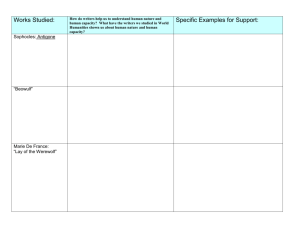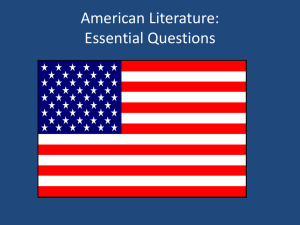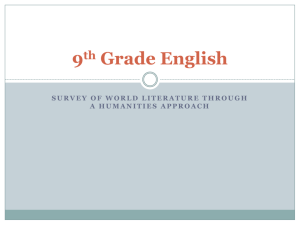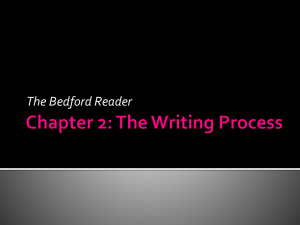A Curricular Plan for the Reading Workshop
advertisement
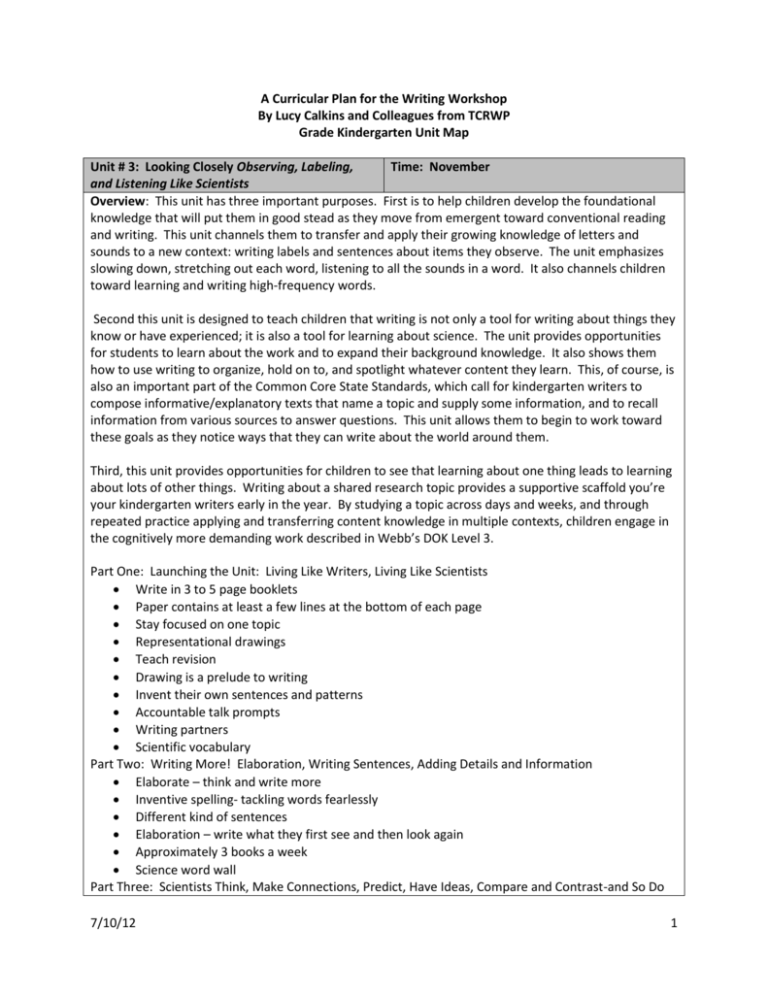
A Curricular Plan for the Writing Workshop By Lucy Calkins and Colleagues from TCRWP Grade Kindergarten Unit Map Unit # 3: Looking Closely Observing, Labeling, Time: November and Listening Like Scientists Overview: This unit has three important purposes. First is to help children develop the foundational knowledge that will put them in good stead as they move from emergent toward conventional reading and writing. This unit channels them to transfer and apply their growing knowledge of letters and sounds to a new context: writing labels and sentences about items they observe. The unit emphasizes slowing down, stretching out each word, listening to all the sounds in a word. It also channels children toward learning and writing high-frequency words. Second this unit is designed to teach children that writing is not only a tool for writing about things they know or have experienced; it is also a tool for learning about science. The unit provides opportunities for students to learn about the work and to expand their background knowledge. It also shows them how to use writing to organize, hold on to, and spotlight whatever content they learn. This, of course, is also an important part of the Common Core State Standards, which call for kindergarten writers to compose informative/explanatory texts that name a topic and supply some information, and to recall information from various sources to answer questions. This unit allows them to begin to work toward these goals as they notice ways that they can write about the world around them. Third, this unit provides opportunities for children to see that learning about one thing leads to learning about lots of other things. Writing about a shared research topic provides a supportive scaffold you’re your kindergarten writers early in the year. By studying a topic across days and weeks, and through repeated practice applying and transferring content knowledge in multiple contexts, children engage in the cognitively more demanding work described in Webb’s DOK Level 3. Part One: Launching the Unit: Living Like Writers, Living Like Scientists Write in 3 to 5 page booklets Paper contains at least a few lines at the bottom of each page Stay focused on one topic Representational drawings Teach revision Drawing is a prelude to writing Invent their own sentences and patterns Accountable talk prompts Writing partners Scientific vocabulary Part Two: Writing More! Elaboration, Writing Sentences, Adding Details and Information Elaborate – think and write more Inventive spelling- tackling words fearlessly Different kind of sentences Elaboration – write what they first see and then look again Approximately 3 books a week Science word wall Part Three: Scientists Think, Make Connections, Predict, Have Ideas, Compare and Contrast-and So Do 7/10/12 1 Writers! Continue the work of making observations colleting information and details, and recording those details on the page through drawing and writing labels and sentences Extend the work for some Push to ask ‘Why’ Make a prediction or hypothesis Maybe or probably are good prompts Compare and contrast Same and different Wonder and question Use what they know to write Part Four: Finishing Up Our Books, Getting Ready to Present Our Work Ramp up the reading work Use everything they know from Reading Workshop to read their own writing 1-1 match, making sure it makes sense, sounds good, and looks right Reread in smooth voices Clear sense of audience Fancy it up During this unit: Scientists and writers, both, observe carefully and then work to capture exactly what they see onto the page. Good writers are resourceful word solvers, saying words slowly and listening for the constituent sounds, representing each sound with a letter. Writers also use what they know to spell the words (and parts of words) they don’t know. Writers and scientists, both, revise. Revision can include adding more detail, fixing up confusing parts, using the words that experts use. Choose a science topic Collect stuff Baggies for collections Books on topic for read aloud and that students can read Special kinds of paper Read-alouds that celebrate paying close attention Longer stretches of writing Teach representational drawing 3-5 page booklets with lines on the bottom Stage 1 – Common Core State Standards and Indicators– What must students know and be able to do? Writing W.02 Use a combination of drawing, dictating, and writing to compose informative/explanatory texts in which they name what they are writing about and supply some information about the topic. W.03 Use a combination of drawing, dictating, and writing to narrate a single event or several loosely linked events in the order in which they occurred, and provide a reaction to what happened. W.05 With guidance and support from adults, respond to questions and suggestions from peers and add details to strengthen writing as needed. Speaking and Listening SL.05 Add drawings and other visual displays to descriptions as desired to provide 7/10/12 2 additional detail. Language L.01 Demonstrate command of the conventions of standard English grammar and usage when writing or speaking. L.02 Demonstrate command of the conventions of standard English capitalization, punctuation, and spelling when writing Essential Questions for Students Guiding Questions for Teachers 1. How can I learn to look really closely at 1. How can I guide my students to observe and the world like a scientist and write record and object or collection of objects like down what I see? How can I notice scientists, noticing detail, and adding it to their what mentor authors do in their books information books? to make mine even better? 2. How can I help my student study mentor 2. How can I be my own problem-solver, informational texts, applying what they notice stretching out the words I want to use, (e, g, precise scientific vocabulary) whispering to a friend for help, or 3. How can I help my students become looking at a chart or book without researchers who study science topics on their anyone telling me to? own-making connections and predictions, asking questions, and comparing and contrasting? 4. How can I help my students to elaborate – to write with more detail, more sentences, and more of a mix of facts and thinking-while simultaneously pushing them to a brave and resourceful word-solvers teach writers to slow down their writing to say words slowly and listen for more than the beginning sound? Stage 2– Common Assessment – What is the evidence of understanding? Universal Screen Formative Assessment Strategies Writing On Demand Writing on Demand -pre unit assessment -post unit assessment Individual writing conferences 7/10/12 3 Common Assessment Stage 3 – Instruction – What learning experiences will lead to understanding? Key Terms/Vocabulary Skills: Content Skills Drawing Academic Technical Vocabulary Labeling Scientist Spelling Notice Stretching out words slowly Wonder Writing down sounds you hear Question Reread Compare Plan Label Adding details Stretch thinking Stretch word Guess/prediction Detail Connections Pattern Revise Compare/contrast Tier Two Vocabulary Revise Before Fancy up Down Make Help Because One Possible Sequence of Teaching Points (A Note To Teachers: Please remember that this is one possible sequence of teaching point that could be used during whole class minilessons, mid-workshop teaching points, teaching shares and could also support some small group instruction. Teachers will alter this list, especially by adding to it in order to respond to students’ needs, making sure to avoid extending the unit beyond the month. Based on the students in your class, you may decide to spend more time on some things and not others. This is a guide to help you make decisions based on the learners in front of you.) Part One: Launching the Unit: Living Like Writers, Living Like Scientists How can I guide my students to observe and record an object or collection of objects like scientists, noticing detail, and adding it to their information books? “Today I want to teach you that writers are like scientists; we both live wide-awake lives, looking closely at the world around us to learn new things and to share what we learn with others. Like scientists, writers look at things differently—we notice things that most ordinary 7/10/12 4 people just walk right past. Instead of walking past the everyday things, writers stop to jot down our thoughts and observations, using words and pictures to capture every detail. As scientists, we have already been jotting down a lot of things we are noticing about the trees and leaves around us, and today I want to teach you that writers can write down our observations in booklets, so that we can share what we learn about the world around us with others. Tip: “Scientists don’t only draw careful observations of what we see, scientists also add labels beside our drawings so others know what things are. So, as we record what we see, we will want to be sure to do this too.” “Today I want to teach you that when we are writing like scientists, we need to try to capture what we see, exactly the way we find it. So if there is a hole in the leaf we are writing about, we don’t just make a dot, we draw a hole. We need to look closely as we draw and write about the things we see, including exact details as we see them.” “If we want others to read about our scientific findings, we need to help them to do this! In order for others to read our writing, we need to spell words the best we can. Today, I am going to teach you that one way you can be sure to get down as many sounds as you can is by stretching out your words slowly, writing down all of the sounds that you hear. You can say the word you want to write, listening o the first sound you hear to get the first letter down. Then, say the word again, listening for the next sound in the word; put down the letter that makes that sound. Keep doing this until you have as many sounds down as you hear! Remember to just do the best you can!” Tip: “You may have to say the word five times, but the more sounds you get down, the easier it will be for someone to read.” Tip: “As you write, you might stop to reread what you have recorded. You could put your finger under what you have written, as you read the word. Sometimes as you reread a word, you realize, ‘Oops. I forgot to put one of the sounds onto the paper,’ and then you can add more letters.” “Today I want to teach you that before we start writing, we plan what we will teach others, but we also plan for other things! We plan how we want our book to go and what it might sound like: Will it be a book that teaches what things are? Or what they do? Or do we want to ask our reader questions? We might even try a few ways our book could sound before we choose the one that best fits our plan.” “Today I want to teach you that writers make plans to teach lots and lots! Before you start writing, you might look at your just-right books to see how long those books are, then you might say: I know lots of facts to make my book just as long! One way to do this is to say all of the stuff you want to teach across your fingers and then grab a booklet to write down all of the stuff you want to include so that you make books just like the ones you are reading!” “Writers often talk to others about what we are planning to write, before we even get our pencils ready. Today I want to teach you that sometimes it might help to work with a partner first, before we start to write a new book. We can ask our partner, ‘What are you going to write today?’ and listen carefully to all that our partner says. We might even get more ideas for what to teach just from listening to what our partner plans to do!” Tip: “When writers are stuck, first we try our best and move on, but sometimes we all need a little help. During independent writing time, when we really aren’t sure what to do, or can’t remember what something is called, we can whisper to our writing partner for help, then go right back to our own work.” Part Two: Writing More! Elaboration, Writing Sentences, Adding Details and Information How can I help my students study mentor informational writing texts, applying what they notice (e.g. precise scientific vocabulary) to their own pieces to make these better? “As writers and scientists, we need to look again and again, adding to our pictures and our words. After we draw and write about a leaf, we look again at the leaf, really closely, maybe with a magnifying glass. We try to find any details we may have missed. Today I want to show you that 7/10/12 5 as writers we can always add more details to our pictures and to our words.” Tip: “You may even decide to start a new page, zooming in on the details!” “Today I want to teach you that writers use drawings and labels to remind us of what we want to say, and then we can go back to add more, adding our ideas about the stuff we’ve put onto the page. Sometimes what we write on one page gets us started, and we end up writing in a pattern, saying similar things on every page.” “Scientists use lots of fancy words to talk to one another. For example scientists who look closely at birds call themselves ornithologists, and those who look closely at stars are said to study astronomy. Today, I want to teach you that when we are writing like scientists we will want to be more scientific and exact, using the same kinds of words that other scientists do. We can use the charts, books, and other words that we see around the room to make our words more precise and exact. As we write, we might stop to think, ‘Wait, do I know another word to describe this?’ or ‘Is there a word in the room that can help describe or name what it is that I am talking about?’ Then we can find those words and add them to our books.” “Today I want to teach you that as writers we often see what other authors have done in their books to get ideas for what we might do in our own. Writers look over a book and think, ‘How does this whole book go?’ and then think, ‘How do I want my book to go?’ For example you might read a book about leaves and ask ‘How did this writer sort the leaves?’ Then you might think about how you could sort your information in a similar way.” Part Three: Scientists Think, Make Connections, Predict, Have Ideas, Compare and Contrast—And So Do Writers! How can I help my students become researchers who study science topics on their own-making connections and predictions, asking questions, and comparing and contrasting? 7/10/12 “Writers, I am so impressed with how you have gotten the hang of looking closely at the things around you, making observations to then write about in your books the way scientists do. Today I want to teach you that scientists not only record what we see, but we also add information based on what we already know. We can write about all of the parts of an object, like a tree or a flower, even if the parts aren’t right there in front of us.” Tip: “Even if we just have a stack of leaves right in front of us, we can write books about ‘Different kinds of trees,’ or ‘Why leaves change color,’ or ‘Trees in our neighborhood.’ We have learned all about trees and leaves and can say so much more than just listing the details that we see in front of us.” “Are you ready for a whole new kind of work? If you are, then today I want to teach you that scientists don’t just collect tons and tons of stuff, writing it all down in any old way. Instead scientists also try to figure out how to sort things into ‘piles that go together.’ Then scientists draw and write to teach people about why these ‘piles go together.’” Tip: “For example you may group leaves into piles by color or by shape—green leaves/yellow leaves, big leaves/small leaves or maybe ripped leaves/smooth leaves. You will probably come up with lots of ways to sort them. And when you get a big idea about something you are studying, like leaves, then you will want to write books to share that idea. So, you could write, ‘Leaves come in all sizes’ and then talk about different sizes in different sections of your book.” “Today I want to teach you that scientists not only record exactly what we see right in front of us, and what we already know, but scientists can also push themselves to think, ‘Why? Why do leaves fall to the ground?’ As we write our books we can ask questions that start with ‘Why does . . .?’ or ‘What is the reason . . .?’ We can write our observations and thoughts and questions in our science books.” Tip: “Then we can stretch our thinking even further by making a guess or a prediction about the answer by saying, maybe or probably or could it be? We can use what we know about science to develop a good hypothesis (or guess) about the answer to our 6 questions to include as well.” “Today I want to teach you that writers often look closely at objects to notice and write about what is the same, and what is different. We can write what we notice using our chart of compare/contrast language: ‘I noticed . . . is the same as . . . ’ ‘They both . . . ’ ‘I noticed . . . is different from . . . ’ ‘One has . . . but the other has . . ..’” “We want others to be able to read the books we write. So like we always do, we want to spell words the best that we can. Today I want to remind you that one tool we can use to check our words is the word wall. If you find words in your books that are on the word wall, check the word on the wall, get the spelling in your mind, then look away from the word wall and see if we can still remember how to spell the word. Write it down and do a final check to see if you were right.” Tip: “We also need to be brave and do our best with hard-to-spell words. We don’t need to be scaredy-cat writers and only write the words that are on the word wall! No way! We are scientists, and scientists need to be brave enough to write the exact true word, even if we don’t know the exact true spelling of it we just do our best.” “Today I want to teach you that science writers try to think of the best ways to describe what we notice, so that others can learn as much as possible about the topic that we are writing about. One way writers do this is to compare what we are writing about to something that people would already know and be familiar with, like ‘Some leaves are as colorful as . . . a party dress!’ If you think that most of your readers will know about dresses, then this comparison will help them to think about leaves. Comparing objects with familiar things can help people to really picture what you are writing about.” Part Four: Finishing Up Our Books, Getting Ready to Present Our Work How can I help my students to elaborate – to write with more detail, more sentences, and more of a mix of facts and thinking-while simultaneously pushing them to a brave and resourceful word-solvers teach writers to slow down their writing to say words slowly and listen for more than the beginning sound? “Writers, we are in the home stretch of our unit. Do you know what a home stretch is? In a horse race, the home stretch is that final part in the track, when the finish line is right ahead, and the crowd starts cheering like crazy because pretty soon the whole terrific race will be over. Well, we are entering the final stretch of our unit. So our work will change, as it always does for writers when we are in the home stretch. You ready? Today I want to teach you that whether a writer is a scientist-writer, a story writer, a fairy tale writer, or a newspaper writer, writers always take the last few days to look back over all we have written to decide ‘What’s good here that is worth revising and sharing with the world?’ We put all our good stuff in a revision folder, and then we start revising it. And to ‘revise’ means to ‘re-see,’ to look again at what we have done and to ask, ‘How can I make this good work into terrific work?’ Writers reread our writing and put Post-its on all the parts where we think we can make our work even better— then we get going!” “Today I want to teach you that as writers we don’t just automatically put our books away on the ‘finished’ side of our folders when we think we are done. Instead we reread our books a couple of times and think to ourselves, ‘Do I have more to add to my labels? To my pictures? To my sentences? Do I have more to say about what I see . . . where I see it . . . and why it looks or feels this way?’ Writers often say more and think, ‘Wait, I want to tell more information, to be more specific.’ We don’t just say, ‘I see a hole in the leaf.’ We say, ‘I see a hole in a leaf, and maybe a caterpillar made the hole.’ Or, ‘This leaf has spikes. The spikes are on the top.’ We can add more into our pattern books when we think we have more to add.” Tip/Possible mid-workshop teaching point:“I saw some of you adding tons more labels—like you were labeling not just leaf but also stem, edge, bug bite, and things like that. And some of you were adding lots of words to your labels, like ‘skinny long stem.’ Some of you had written one sentence at the bottom of each page, like, ‘I see the leaf.’ And you thought, ‘I can add so much more!’ So you added more. I thought maybe I’d 7/10/12 7 teach all of you to do what some of you were already doing, okay? So today I want to teach you that as writers we reread our books and we ask ourselves, ‘What do I think about this?’ and we add what we think to the page.” Tip: “Writers sometimes reread our writing and find ourselves wondering and having questions about things. So, we add questions to get the reader wondering, too. For example, Jessica reread her book, ‘I see a hole.’ She added, ‘How did the hole get there? I wonder if a ladybug ate it.’” “Today I want to teach you that neither writers nor scientists wait for teachers to tell them how to revise our writing. No way! Writers don’t come up to teachers and say, ‘Please, Miss, how do I make my writing better?’ and then just do what the teacher says. No way. As writers we are the boss of our own writing. We reread our books and think, ‘What else can I add?’ And then we look to charts, books, or other kid writers to get tons and tons of cool ideas.” “Today I want to remind you of something you already know. We have already been fixing up our writing. Writers not only fix up our writing, we also fancy up our writing so that it is ready to be published.” Tip: “I’ve brought the list out from the last unit of ways to fix and fancy up our writing. of course you know that we can look back on old charts to get ideas for what we can do, but we can also add to those old charts. I’m wondering if there are other ideas you have for how we could fix and fancy up our writing?” Resources: Calkins, Lucy and Colleagues. 2011. A Curricular Plan for the Writing Workshop Grade K. Portsmouth, NH: Heinemann. Calkins, Lucy and Kathleen Tolan. 2010. Building a Reading Life: Stamina, Fluency and Engagement. Portsmouth, NH: Heinemann. Mentor Texts Determined by personal preference Texts Used (fiction, non=fiction, on-line, media, etc..) Kindergarten Units of Study, Unit 3 Reading and Writing Continuum Materials Used Possible Read Alouds: Baylor’s I’m in Charge of Celebrations (1995), or The Other Way to Listen (1997), Joanne Ryder’s books, Valerie Worth’s poems- All the Small Poems and Fourteen More 1996). Possible charts: rules/habits/routines of writing workshop, planning pages, stretching ideas over a few pages, how to draw our ideas, partner talk, 3-5 page booklets with a large box and two lines (adapt paper to more lines according to observations) Writing center: writing pens, stapler, date stamp, differentiated paper baskets Writing folders Word wall with names Alphabet chart Professional Texts Please see the forthcoming book aligned to this unit from Units of Study for Teaching Writing, Grade by Grade: A Yearlong Workshop Curriculum, Grade K 7/10/12 8 Calkins, Lucy and Pessah, Laurie. 2003. Units of Study for teaching Writing: Nonfiction Writing: Procedures and Reports. Portsmouth, NH: Heinemann. Horn, Martha and Giacobbe, Mary Ellen. 2007. Talking and Drawing, Writing: Lessons for Our Youngest Writers. Portland, ME: Stenhouse. McGee, Lea M. and Morrow, Lesley M. 2005. Teaching Literacy in Kindergarten. New York: Guilford Press Ray, Katie and Cleveland, L. 2001. Writing Workshop with out Youngest Writers. Portsmouth, NH: Heinemann. Websites and Technology Differentiated Instructions: Small Group Finding opportunities for small group instruction is essential for all of your kindergarten children, right from the start. ELL: Some students can write in their native language and we need to honor that at this point in their progress. Students need to have picture mentor support to help them see and understand what we are teaching. Special Education: Modifications should always be based on IEPs. Students who have occupational issues may have someone write for them or they may speak to a computer, which will write for them. Interactive Writing: Students should write and share the pen with you to help them see and own what writers do. 7/10/12 9


